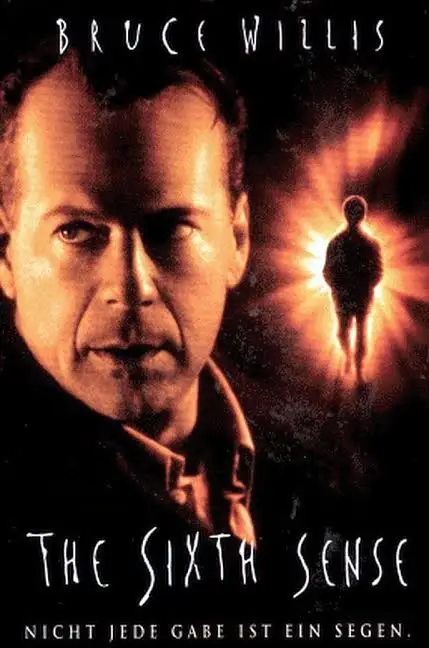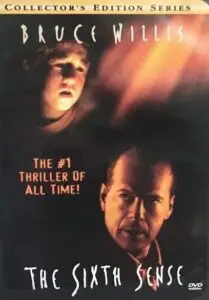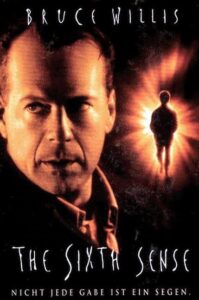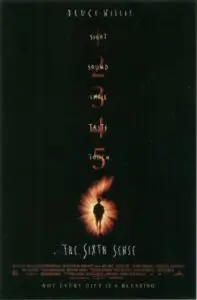
What Makes The Sixth Sense So Scary? Themes of Fear and Revelation Explored
Introduction
M. Night Shyamalan’s The Sixth Sense (1999) is a psychological thriller that captivated audiences worldwide with its haunting atmosphere, emotional depth, and jaw-dropping twist. Featuring standout performances by Bruce Willis and Haley Joel Osment, this film blends supernatural elements with a deeply human story about trauma, connection, and redemption. Its famous line, “I see dead people,” has become an enduring part of pop culture, reminding viewers of the film’s brilliance.
Plot Summary
The Mysterious Encounter
The story begins with Dr. Malcolm Crowe (Bruce Willis), a celebrated child psychologist, enjoying a quiet evening with his wife. Their peace is shattered when a former patient, Vincent Grey (Donnie Wahlberg), confronts Malcolm about perceived failures in treatment. In a violent outburst, Vincent shoots Malcolm and then himself, leaving Malcolm to grapple with guilt and self-doubt.
Meeting Cole Sear
Months later, Malcolm starts working with Cole Sear (Haley Joel Osment), a troubled 9-year-old boy who exhibits strange behaviors. Cole is withdrawn, plagued by fear, and reluctant to share the source of his distress. Gradually, he reveals his secret: he sees dead people.
Malcolm, initially skeptical, slowly comes to believe Cole’s claims as he witnesses inexplicable phenomena. Determined to help the boy, Malcolm uses his professional skills to guide Cole through his terrifying experiences.
Unraveling the Mystery
Cole’s ability to communicate with spirits is both a curse and a gift. Through Malcolm’s encouragement, Cole begins to interact with the spirits, helping them find closure. This breakthrough not only empowers Cole but also gives Malcolm a renewed sense of purpose.
Parallel to Cole’s journey, Malcolm struggles to repair his strained relationship with his wife, Anna. His sense of disconnect deepens as Anna seems distant and withdrawn, further complicating his personal turmoil.
The Shocking Twist
The film’s climax delivers one of cinema’s most iconic plot twists: Malcolm discovers he is one of the spirits haunting Cole. He realizes he has been dead since the night Vincent shot him. This revelation reframes the entire narrative, highlighting the subtle clues that Shyamalan masterfully planted throughout the story.
Malcolm accepts his fate and bids a heartfelt farewell to Anna, finding peace in knowing he has helped Cole and, in turn, redeemed himself.

Themes and Symbolism
Grief and Healing
The movie delves deeply into the human experience of grief, exploring how unresolved pain affects both the living and the dead. Malcolm’s journey mirrors Cole’s, as both characters confront their fears and find closure.
Communication and Connection
Cole’s ability to bridge the gap between the living and the dead underscores the importance of understanding and empathy. The bond between Malcolm and Cole exemplifies the power of connection in overcoming fear and isolation.
Redemption and Acceptance
Malcolm’s realization of his death is a poignant moment of self-awareness and redemption. By helping Cole, he not only fulfills his unfinished business but also comes to terms with his own mortality.
Performance Highlights
- Haley Joel Osment delivers a career-defining performance as Cole, capturing the vulnerability and strength of a child burdened by an extraordinary gift. His haunting portrayal earned him an Academy Award nomination.
- Bruce Willis showcases a subdued yet powerful performance as Malcolm, balancing his character’s guilt and determination with finesse.
- Toni Collette shines as Cole’s mother, Lynn, portraying a mother’s love and desperation with heartfelt authenticity.
Cinematography and Direction
M. Night Shyamalan’s direction is a masterclass in building tension and atmosphere. The use of muted colors, symbolic imagery, and deliberate pacing creates an immersive and unsettling experience. James Newton Howard’s haunting score further enhances the film’s emotional depth and suspense.
Reception and Legacy
Upon its release, The Sixth Sense was both a critical and commercial success, grossing over $670 million worldwide. It received six Academy Award nominations, including Best Picture and Best Director. The film’s twist ending has become a hallmark of Shyamalan’s storytelling, influencing countless movies in the years that followed.

Conclusion
The Sixth Sense is more than a ghost story—it’s a profound exploration of human connection, loss, and redemption. Its unforgettable twist, emotional storytelling, and stellar performances make it a timeless masterpiece that continues to resonate with audiences. Whether you’re revisiting it or experiencing it for the first time, The Sixth Sense is a cinematic journey that leaves an indelible mark.
FAQs
- Who directed The Sixth Sense?
M. Night Shyamalan directed this iconic psychological thriller. - What is the movie’s famous twist?
The twist reveals that Dr. Malcolm Crowe, the protagonist, has been dead throughout the story. - What is the central theme of the film?
The movie explores themes of grief, healing, and the importance of connection. - Why is The Sixth Sense considered a classic?
Its combination of a compelling narrative, emotional depth, and a legendary twist solidifies its place in cinematic history. - Did The Sixth Sense win any awards?
While it didn’t win, it was nominated for six Academy Awards, including Best Picture. -
Ratatouille: A Delicious Tale of Dreams and Determination
-
Sleepy Hollow: A Haunting Tale of Mystery and Myth
-
I Am Legend: An Amazing Tale of Survival, Loss, and Redemption
-
“Love Lies Bleeding” Unveiled: A Tale of Passion, Greed, and Consequences
-
“Transformers One” – The Untold Origins of Cybertron’s Greatest Heroes








5 thoughts on “Behind The Sixth Sense: How One Twist Redefined Psychological Thrillers”